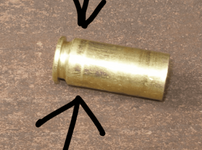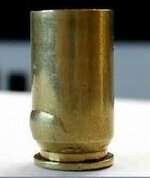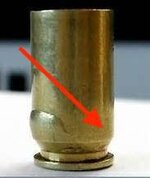It is discussed in the reloading books. I found this one yesterday, as I was thumbing cartridges into the magazine of a 10mm pistol. That is the last call for quality control; that is, just before it gets fed into the firearm. The give-away is the bright annular line or ring, just ahead of the case head. On this one, it was about 50% around the circumference of the head. This is an Underwood branded case. It came to me as once fired; to be honest I don't know the exact round count but no more than two more light loadings. I don't do heavy loads in 10mm although the cartridge has a reputation for it.
If you take a paper clip tool as referred to in the loading manuals, you can kinda rub it around inside the case on the opposite side of the bright ring. There, you will feel the surface of the brass sink in a bit. It's slight, you need to understand the minute nature of the defect you are looking for. The reason for the bright ring is that is where the brass is just starting to expand and blow out. I've seen this several times on rifle brass but it's the first time I've seen a pistol case start to come apart in this manner.

The paper clip tool. You take a simple wire paper clip and unbend it into a straight piece. Then you bend a small leg at the bottom, winding up with an L shape. The bend you make need only be about 1/8 inch long. You are doing this check just to verify; usually the bright ring is enough to tell the story. But I've been fooled a couple of times and found with the wire tool that the case was actually sound and the suspect ring I saw was something other than an incipient separation.
I checked all the rest of the cartridges in this batch and didn't find another similar defect. I also checked the fired brass afterwards and all was okay. Likely I won't reuse these because now they are suspect.
Recently I was at one of the ranges where I'm a member. A shooter down the line from me was firing Swedish 6.5 Mauser hand loads. Every round he fired developed a serious incipient separation. I asked him what his load was, etc. I checked it against book recommendations after I got home and found what he told me was within reasonable specs. So maybe he made a mistake somewhere and his load was more than he thought. He said the PMC brass was weak. Nevertheless, if you see one of your fired cases come out with this kind of defect, it's time to stop shooting and investigate. You don't keep firing away. A guy would look pretty silly with a Mauser bolt sticking out of the front of his forehead. The mistake I made was not reporting him to the RSO. Nobody likes to be a rat, but shooting questionable loads on the range endangers other shooters and is cause for removal from the firing line.
If you take a paper clip tool as referred to in the loading manuals, you can kinda rub it around inside the case on the opposite side of the bright ring. There, you will feel the surface of the brass sink in a bit. It's slight, you need to understand the minute nature of the defect you are looking for. The reason for the bright ring is that is where the brass is just starting to expand and blow out. I've seen this several times on rifle brass but it's the first time I've seen a pistol case start to come apart in this manner.

The paper clip tool. You take a simple wire paper clip and unbend it into a straight piece. Then you bend a small leg at the bottom, winding up with an L shape. The bend you make need only be about 1/8 inch long. You are doing this check just to verify; usually the bright ring is enough to tell the story. But I've been fooled a couple of times and found with the wire tool that the case was actually sound and the suspect ring I saw was something other than an incipient separation.
I checked all the rest of the cartridges in this batch and didn't find another similar defect. I also checked the fired brass afterwards and all was okay. Likely I won't reuse these because now they are suspect.
Recently I was at one of the ranges where I'm a member. A shooter down the line from me was firing Swedish 6.5 Mauser hand loads. Every round he fired developed a serious incipient separation. I asked him what his load was, etc. I checked it against book recommendations after I got home and found what he told me was within reasonable specs. So maybe he made a mistake somewhere and his load was more than he thought. He said the PMC brass was weak. Nevertheless, if you see one of your fired cases come out with this kind of defect, it's time to stop shooting and investigate. You don't keep firing away. A guy would look pretty silly with a Mauser bolt sticking out of the front of his forehead. The mistake I made was not reporting him to the RSO. Nobody likes to be a rat, but shooting questionable loads on the range endangers other shooters and is cause for removal from the firing line.















